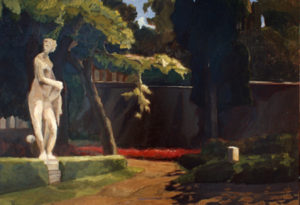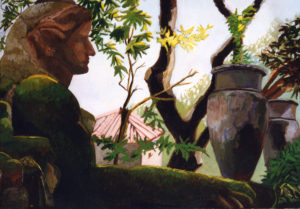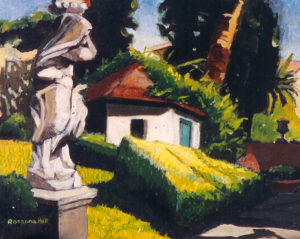Italian gardens call me back this fall. Already I am packing my watercolors, brushes, paper, and easel for the return pilgrimage to my favorite gardens in Rome and Venice.
In “Travel Tales from the Easel,” my memoir, I reflect on the adventure of painting in Italy.

In Venice, I recall, after loading up with my backpack, carrying case, camp stool, and easel wrapped with a bungee cord to use as a carrying handle, I arrive by motor boat at I Giardini, the public park enlivened with statues which animate nature. I draw several charcoal and white chalk sketches of a large stone statue of Leda and the Swan standing to the left of a meandering path, perhaps reminiscent of Giorgione’s famous 16th-century Venetian painting, “Tempesta,” in which he places a nude nursing a child. Stretching behind her is a brick wall and a bed of red flowers (somewhat resembling the distant city of Bassano). The scene is heavily shaded with shafts of light piercing portions of the path. I choose the composition of one of the sketches and begin an oil painting with the same composition. I am happy with the result.

At Bomarzo, a private Renaissance park full of huge stone statues carved out of mountain boulders, I see Ceres, the mythological goddess of grain and fertility. I fall in love with this giant woman who sits regally on green moss as if she were Cleopatra. Her huge clumsy arm stretches along a ridge like a great lion’s paw. Lined up beside her are large stone urns, perhaps containers for wheat. I am inspired to paint.
I sit on my campstool like a lady-in-waiting before Ceres who represents the growing season when fields of grain feed the ancient world. But her life is one of sadness: One lovely summer day, her only daughter Persephone goes in the field to pick wildflowers and is spied by Pluto, god of the underworld. Instantly, he falls in love. He swoops up to earth, grabs her, and takes her to the underworld. When Ceres hears of the kidnapping, she is overcome with grief. For months, she allows the fields of grain to lay fallow. Finally, Zeus, king of Greek gods, decides that Ceres will recover Persephone for half a year while Pluto reclaims the other half. Thus, the mythological growing seasons are created.
As I begin to paint this gigantic Ceres, I wonder if she is asleep during the winter while her daughter Persephone is away in the underworld of the dead. I do an under-drawing on my canvas in charcoal. I secure the charcoal with a spray can of fixative and am ready to paint when the thunder and lightning break apart the sky and the rains come. Just in time, I snap open my folding umbrella and for a busy hour of frantic painting in front of Ceres, I slap wet paint with the brush in my left hand and I fend off the rain with the umbrella in the right. Perched on the stool, I manage with difficulty to balance the palette of paint on my lap. My feet are cold and a puddle of water encircles my stool.
I rush to complete my composition as mud slides under my feet.
Afternoon of the Faun (Villa Sciarra)

In the gardens at Villa Sciarra in Rome, I do a small oil study for the painting, “Afternoon of the Faun.” Near a gravel path is the gardener’s tiny, six-sided tool shed. Shadows fall in strange angles across the yellow ochre walls and steeply pitched, dark weathered roof. As I move around the shed in search of an interesting composition, I also study one of the many faun figures in the park. A faun nearest the tool shed carries a water jar on his head and is cloaked by a hood. Suddenly the relationship between the faun and the old tool shed creates a dialog. The best way to explain my surreal thought is that I see a symbol of a caveman returning to his cave. Hedges, trees, grass, and distant villas jar my thoughts with strange juxtapositions with the cave-like dwelling. According to Greek mythology, Pan is the god of woods and fields and his followers are fauns, which are wood nymphs. Fauns date back to early Greek beliefs that the earth is inhabited by spirits to preserve the laws of nature. At dusk, in Villa Sciarra, I believe I hear the rustle of Pan and his fauns passing through the darkened trees. I grow superstitious and, suddenly, am frightened without any visible cause. I feel Pan-icky. Now I begin to paint this nature spirit as I discover the dialog between shapes and objects in the gardens. I am dancing alongside Pan. With my imagined dialog of a caveman returning to his hut in play, I set to work. This time I have only my drawing pad so I sit down on my stool to recreate the strange scene. The faun is viewed at a low angle as I view his body appearing to turn to the right. He carries his vase on his head. He stands to the left side of the painting with the tool shed further along a path which runs at a diagonal across the bottom of the canvas. The path continues past the shed and toward the Renaissance wall. On the wall, in the distance, I paint a lovely urn filled with flowers. And, beyond the wall, I see villas fade into soft pastel colors.
I am pleased with the drawing and that night I cover the back of the paper with thick charcoal and trace the drawing onto a canvas. The next day I return to Villa Sciarra and paint “Afternoon of a Faun.”
Strolling through the Gardens (Villa Doria Pamphili, Rome)

Aha! I’ve found another garden to paint in Rome and I almost gasp at how perfect a painting it could be. I am enchanted with the hillside terrain of Villa Doria Pamphili located in the Gianicolo hills across the Tiber River from Rome. During the early morning, joggers run along the many meandering pathways. After two hours roaming the park, I stand at the top of a steep flight of stairs at Doria Pamphili. I look down at the light green lawn far below. Running down the hill, as well, is a thick hedge of dark green foliage. I also am looking down at the tops of tall trees. Through the lawn runs a gravel path which draws the eye to a distant bridge. Way up on a far hill, I can see a glistening white villa.
The descending perspective of the stairs is challenging to draw. But I know how to construct vanishing points such as stairways using linear perspective and I think with this knowledge I can match the thrill I feel standing there, alone. So, I sit on my campstool and draw several thumbnails in charcoal and white chalk on grey drawing paper. Once I select a study I like, I set up my easel and draw everything I see in my field of vision. I again use charcoal. After spraying the charcoal with fixative, I paint in the five values from black to white admixed with greens and yellows which dominate the landscape.
The medium I use is fast-drying Maroger medium which consists of boiled lead oil and, probably, some varnish to give the paint a glow. I don’t know the true make-up of Maroger, since I simply mail-order it. The artists who make it follow the complex formula published in a book by Maroger, a former conservator at the Louvre Museum in Paris. His medium resembles mixtures made by Renaissance artists. One of the ingredients is heated white lead paint which was widely used, along with other lethal paints and mediums of oil, turpentine, and varnish.
I become so engrossed in my painting that I don’t realize I am losing daylight. I am hungry and the woodland spirits rustle the tree leaves. So I pack up and lug my new painting in the carrying case in one hand, in the other hand my easel, and in my backpack my painting supplies. I walk along a path through a forest of umbrella pines. The sun sets and forest is growing dark. By the time I reach the street, total darkness engulfs me.
I am so pleased with the study that I plan to do an enlarged version back at my studio in Indianapolis.
